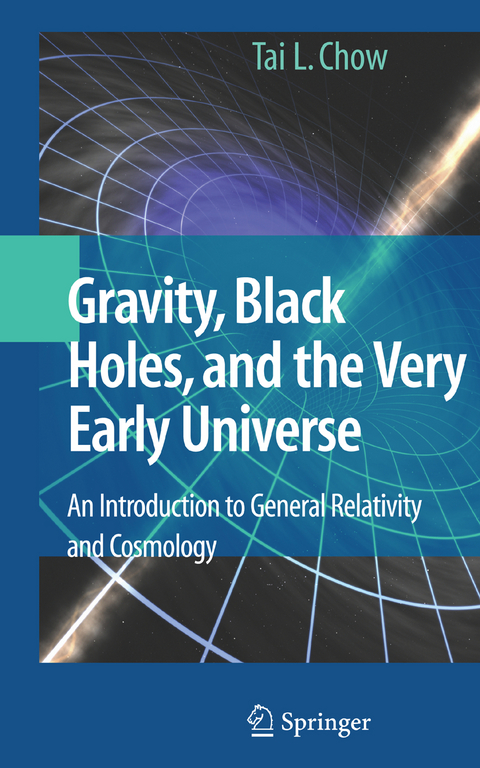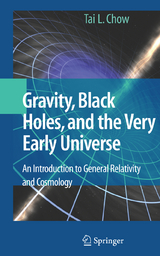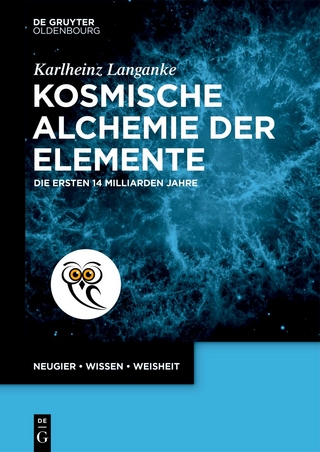Gravity, Black Holes, and the Very Early Universe
An Introduction to General Relativity and Cosmology
Seiten
2007
Springer-Verlag New York Inc.
978-0-387-73629-7 (ISBN)
Springer-Verlag New York Inc.
978-0-387-73629-7 (ISBN)
Deftly employing his inimitable writing style, respected American academic Professor Tai Chow tells us the story of Einstein's key discoveries, weaving into his account an explanation of the structure of the universe and the science of cosmology.
Chow introduces the mathematical methods essential to understanding and applying general relativity--tensor calculus, some differential geometry, etc.--but leaves to more advanced references derivations that a beginning student would likely find overly long and tedious. I like the fact that the author employs standard tensor analysis--which requires only basic calculus for its understanding--and resists the temptation to adopt more powerful mathematical formalisms (like exterior calculus and differential forms) used by researchers in the field. In this way, the student can concentrate on learning physics--and not be distracted by the complexities of unfamiliar mathematical methods.
The book also offers comprehensive discussion of the physics of black holes. Here again the author has hit just the right level of presentation: sufficient mathematical detail to demonstrate or make plausible the physical attributes of black holes (...in contrast to “hand-waving” discussions found in popularisations of the subject), yet not so much mathematics as to lose track of the physics in an impenetrable forest of equations. An equally strong point is the author's discussion of the most exciting contemporary issues in astrophysics apart from black holes: recent measurements of the cosmic microwave background, the existence of the cosmological constant, dark matter, dark energy and the accelerated expansion of the universe. The final chapters on unification and inflation are also very well done and not generally found (as far as I can tell) in other introductory treatments of general relativity.
In sum, the book is highly informative and has a user-friendly style, which should make it an attractive choice for teachers and students.
Chow introduces the mathematical methods essential to understanding and applying general relativity--tensor calculus, some differential geometry, etc.--but leaves to more advanced references derivations that a beginning student would likely find overly long and tedious. I like the fact that the author employs standard tensor analysis--which requires only basic calculus for its understanding--and resists the temptation to adopt more powerful mathematical formalisms (like exterior calculus and differential forms) used by researchers in the field. In this way, the student can concentrate on learning physics--and not be distracted by the complexities of unfamiliar mathematical methods.
The book also offers comprehensive discussion of the physics of black holes. Here again the author has hit just the right level of presentation: sufficient mathematical detail to demonstrate or make plausible the physical attributes of black holes (...in contrast to “hand-waving” discussions found in popularisations of the subject), yet not so much mathematics as to lose track of the physics in an impenetrable forest of equations. An equally strong point is the author's discussion of the most exciting contemporary issues in astrophysics apart from black holes: recent measurements of the cosmic microwave background, the existence of the cosmological constant, dark matter, dark energy and the accelerated expansion of the universe. The final chapters on unification and inflation are also very well done and not generally found (as far as I can tell) in other introductory treatments of general relativity.
In sum, the book is highly informative and has a user-friendly style, which should make it an attractive choice for teachers and students.
Tai L. Chow is Professor of Physics at California State University, Stanislaus. He has written a successful text on Mathematical Methods with Cambridge University Press: Chow, Mathematical Methods for Physicists: A Concise Introduction (Cambridge, ISBN 0521655447 , 555 pp., Hardcover, $58.00 [Hardcover: $120.00], 7/2000)
Basic Ideas of General Relativity.- Curvilinear Coordinates and General Tensors.- Einstein's Law of Gravitation.- The Schwarzschild Solution.- Experimental Tests of Einstein's Theory.- The Physics of Black Holes.- to Cosmology.- Big Bang Models.- Particles, Forces, and Unification of Forces.- The Inflationary Universe.- The Physics of the Very Early Universe.
| Erscheint lt. Verlag | 26.10.2007 |
|---|---|
| Zusatzinfo | XVI, 280 p. |
| Verlagsort | New York, NY |
| Sprache | englisch |
| Maße | 155 x 235 mm |
| Themenwelt | Naturwissenschaften ► Physik / Astronomie ► Astronomie / Astrophysik |
| Naturwissenschaften ► Physik / Astronomie ► Relativitätstheorie | |
| Naturwissenschaften ► Physik / Astronomie ► Theoretische Physik | |
| ISBN-10 | 0-387-73629-8 / 0387736298 |
| ISBN-13 | 978-0-387-73629-7 / 9780387736297 |
| Zustand | Neuware |
| Informationen gemäß Produktsicherheitsverordnung (GPSR) | |
| Haben Sie eine Frage zum Produkt? |
Mehr entdecken
aus dem Bereich
aus dem Bereich
die Geschichte und Erforschung unserer Galaxie
Buch | Hardcover (2023)
C.Bertelsmann (Verlag)
30,00 €
Die ersten 14 Milliarden Jahre
Buch | Softcover (2024)
De Gruyter Oldenbourg (Verlag)
44,95 €




